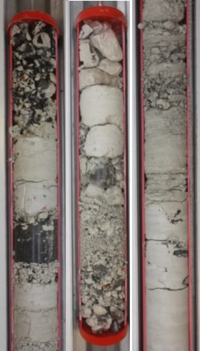Introduction and background
Contents
Introduction and background
The understanding of the fate and transport behavior of contaminant plumes from contaminated sites in limestone aquifers is important because these aquifers are often a major drinking water resource. This is challenging because limestone aquifers may be heavily fractured and contain chert layers and nodules, resulting in a complex flow and transport behavior. Standard field methods may give poor or misleading results and more advanced techniques, which can give information about processes and conditions in the fractures and in the limestone matrix are required. Different field methods have been developed in the past to better characterize the flow field and transport behavior in such aquifers. Moreover, specialized methods for determining aquifer parameters and estimating the contaminant distribution in fractured aquifers have been shown to be useful.
This wiki gives an overview of some useful methods for the assessment of contaminant plumes in fractured limestone aquifers and evaluates their effectiveness. The focus is on dissolved chlorinated solvents (PCE, TCE etc.) as contaminants. A pumping test combined with multiple tracer injections and contaminant sampling was conducted at a PCE contaminated field site close to Copenhagen. This gave some important insights and the implications on the conceptual understanding of processes in fractured limestone will be discussed.
Modeling can help with the planning and interpretation of field work and is a viable tool for the prediction of the contaminant behavior in the aquifer. It is, however, important to select an appropriate model, which accounts for the fractured nature of the aquifer and does not oversimplify the studied system, leading to wrong predictions. Then, it can be used as a tool to advance the conceptual understanding and aid with decision support for risk assessment and remedial site management.
Fracture flow and transport models with different complexity are available for the modeling of contaminant transport, ranging from simple spreadsheet tools to advanced models that incorporate the fracture geometry. This wiki aims at giving an overview of modeling tools that can be used for the interpretation and prediction of flow and transport processes in fractured limestone aquifers (Chapter Model concepts). The models will be compared for their suitability to simulate field data and to represent typical features of fracture flow and transport based on a field example (Example: Akacievej). Based on the field example, it will be exemplified how to establish a conceptual model for a contaminated site and how different field measurements contribute to the model. The steps how to build up a suitable numerical model will be described and recommendations for a good modeling practice will be made.
Physical processes
Advection, diffusion and dispersion, fracture flow, sorption and retardation
Governing equations
Flow
Groundwater flow in porous media is usually described by Darcy's law, giving a relation between hydraulic head gradient and groundwater flow. The fracture conductivity is usually determined via the fracture aperture using the cubic law.
Darcy's law.
Cubic law.
Flow equation.
Contaminant transport
To describe the transport of a substance in a porous medium, the advection-dispersion equation is usually employed. It includes the storage, advective and dispersive transport of a substance. Retardation due to sorption and degradation can be included.
Properties of limestone
Low conductive matrix - can be heavily fractured - chert layers and nodules - sorption behavior for chlorinated solvents
Return to Overview
